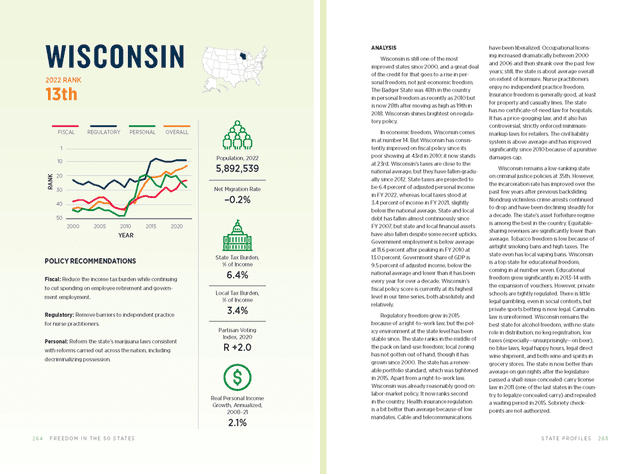Policy Recommendations
- Fiscal Reduce the income tax burden while continuing to cut spending on employee retirement and government employment.
- Regulatory Remove barriers to independent practice for nurse practitioners.
- Personal Reform the state’s marijuana laws consistent with reforms carried out across the nation, including decriminalizing possession.
Analysis
Wisconsin is still one of the most improved states since 2000, and a great deal of the credit for that goes to a rise in personal freedom, not just economic freedom. The Badger State was 48th in the country in personal freedom as recently as 2010 but is now 28th after moving as high as 19th in 2018. Wisconsin shines brightest on regulatory policy.
In economic freedom, Wisconsin comes in at number 14. But Wisconsin has consistently improved on fiscal policy since its poor showing at 43rd in 2010; it now stands at 23rd. Wisconsin’s taxes are close to the national average, but they have fallen gradually since 2012. State taxes are projected to be 6.4 percent of adjusted personal income in FY 2022, whereas local taxes stood at 3.4 percent of income in FY 2021, slightly below the national average. State and local debt has fallen almost continuously since FY 2007, but state and local financial assets have also fallen despite some recent upticks. Government employment is below average at 11.6 percent after peaking in FY 2010 at 13.0 percent. Government share of GDP is 9.5 percent of adjusted income, below the national average and lower than it has been every year for over a decade. Wisconsin’s fiscal policy score is currently at its highest level in our time series, both absolutely and relatively.
Regulatory freedom grew in 2015 because of a right-to-work law, but the policy environment at the state level has been stable since. The state ranks in the middle of the pack on land-use freedom; local zoning has not gotten out of hand, though it has grown since 2000. The state has a renewable portfolio standard, which was tightened in 2015. Apart from a right-to-work law, Wisconsin was already reasonably good on labor-market policy. It now ranks second in the country. Health insurance regulation is a bit better than average because of low mandates. Cable and telecommunications have been liberalized. Occupational licensing increased dramatically between 2000 and 2006 and then shrank over the past few years; still, the state is about average overall on extent of licensure. Nurse practitioners enjoy no independent practice freedom. Insurance freedom is generally good, at least for property and casualty lines. The state has no certificate-of-need law for hospitals. It has a price-gouging law, and it also has controversial, strictly enforced minimum-markup laws for retailers. The civil liability system is above average and has improved significantly since 2010 because of a punitive damages cap.
Wisconsin remains a low-ranking state on criminal justice policies at 35th. However, the incarceration rate has improved over the past few years after previous backsliding. Nondrug victimless crime arrests continued to drop and have been declining steadily for a decade. The state’s asset forfeiture regime is among the best in the country. Equitable-sharing revenues are significantly lower than average. Tobacco freedom is low because of airtight smoking bans and high taxes. The state even has local vaping bans. Wisconsin is a top state for educational freedom, coming in at number seven. Educational freedom grew significantly in 2013–14 with the expansion of vouchers. However, private schools are tightly regulated. There is little legal gambling, even in social contexts, but private sports betting is now legal. Cannabis law is unreformed. Wisconsin remains the best state for alcohol freedom, with no state role in distribution, no keg registration, low taxes (especially—unsurprisingly—on beer), no blue laws, legal happy hours, legal direct wine shipment, and both wine and spirits in grocery stores. The state is now better than average on gun rights after the legislature passed a shall-issue concealed-carry license law in 2011 (one of the last states in the country to legalize concealed carry) and repealed a waiting period in 2015. Sobriety checkpoints are not authorized.

